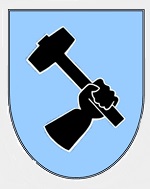Corgi AA38807 German Dornier Do17Z-2 Light Bomber - U5 + BH, "Operation Undertaking Marita", 1./Kampfgeschwader 2 "Holzhammer", Tatoi, Greece, May 1941 (1:72 Scale)
"Guns before butter. Guns will make us powerful; butter will only make us fat."
- Reichsmarschall Hermann Goering, Head of the German Luftwaffe
 The Dornier Do 17, sometimes referred to as the Fliegender Bleistift ("flying pencil"), was a World War II German light bomber produced by Claudius Dornier's company, Dornier Flugzeugwerke. It was designed as a Schnellbomber, a light bomber, which in theory, would be so fast that it could outrun defending fighter aircraft.
The Dornier Do 17, sometimes referred to as the Fliegender Bleistift ("flying pencil"), was a World War II German light bomber produced by Claudius Dornier's company, Dornier Flugzeugwerke. It was designed as a Schnellbomber, a light bomber, which in theory, would be so fast that it could outrun defending fighter aircraft.
The Dornier was equipped with two radial engines, mounted on a "shoulder wing" structure and possessed a Twin tail vertical stabilizer configuration. Designed in the early 1930s, it was one of the three main Luftwaffe bomber types used in the first three years of the war. The Do 17 made its combat debut in 1937 during the Spanish Civil War, operating in the Condor Legion in various roles. Along with the Heinkel He 111 it was the main bomber type of the German air arm in 1939-40. The type was popular among its crews due to its manoeuvrable handling at low altitude, which made the Dornier capable of surprise bombing attacks. Its sleek and thin airframe made it harder to hit than other German bombers, as it presented less of a target.
The Dornier was used throughout the war, and saw action in significant numbers in every major campaign theatre as a front-line aircraft until the end of 1941, when its effectiveness and usage was curtailed as its bomb load and range were limited. Production of the Dornier ended in the summer of 1940, in favour of the newer and more powerful Junkers Ju 88. The successor of the Do 17 was the Dornier Do 217, which started to appear in strength in 1942. Even so, the Do 17 continued service in the Luftwaffe in various roles until the end of the war, as a transport, test and trainer aircraft. A considerable number of surviving examples were sent to other Axis nations. A small production run of an updated version known as the Do 215 was also produced for export, but ended up in Luftwaffe service. Production of the Do 215 ceased in January 1941. Few of the Dornier Do 17s survived the war. The last was scrapped in Finland in 1952.
This 1:72 scale model represents a Dornier Do17Z-2 light bomber that was attached to to 1./Kampfgeschwader 2 "Holzhammer" then deployed to Tatoi, Greece, during May 1941 and participating in Operation Undertaking Marita.
Sold Out!
Dimensions:
Wingspan: 9-3/4-inches
Length: 8-3/4-inches
Release Date: September 2017
 Historical Account: "Schnellbomber Vor" - Developed during the early 1930s under the restrictions of the Treaty of Versailles, the Dornier Do17 was originally described as a freight aircraft for the German State Railway and a high-speed mail aircraft for Lufthansa. The aircraft was in fact a new breed of fast attack aircraft, or Schnellbomber, which was intended to carry out lightning bombing attacks, at speeds making it almost impervious to enemy fighter attack. With its sleek tapering fuselage, the Do17 was nicknamed "The Flying Pencil" and whilst this design certainly prevented the aircraft from carrying anything other than a modest bomb load, its profile made it more difficult to target in the melee of a dogfight. Seeing extensive service in the early part of WWII, the Do17s of KG.2 would support Luftwaffe operations during "Operation Marita" as the Wehrmacht attempted to invade Allied occupied Greece, following a failed Italian offensive. Attacking ground and coastal targets, the Dorniers also took a heavy toll of Allied shipping in the Mediterranean theatre.
Historical Account: "Schnellbomber Vor" - Developed during the early 1930s under the restrictions of the Treaty of Versailles, the Dornier Do17 was originally described as a freight aircraft for the German State Railway and a high-speed mail aircraft for Lufthansa. The aircraft was in fact a new breed of fast attack aircraft, or Schnellbomber, which was intended to carry out lightning bombing attacks, at speeds making it almost impervious to enemy fighter attack. With its sleek tapering fuselage, the Do17 was nicknamed "The Flying Pencil" and whilst this design certainly prevented the aircraft from carrying anything other than a modest bomb load, its profile made it more difficult to target in the melee of a dogfight. Seeing extensive service in the early part of WWII, the Do17s of KG.2 would support Luftwaffe operations during "Operation Marita" as the Wehrmacht attempted to invade Allied occupied Greece, following a failed Italian offensive. Attacking ground and coastal targets, the Dorniers also took a heavy toll of Allied shipping in the Mediterranean theatre.


